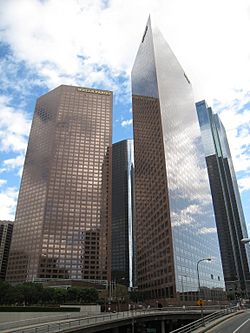Wells Fargo Center (Los Angeles) facts for kids
Quick facts for kids Wells Fargo Center |
|
|---|---|

Wells Fargo Tower (left), and KPMG Tower
|
|
| Alternative names | Crocker Center Crocker Center North & South Wells Fargo Center I & II IBM Tower |
| General information | |
| Type | Commercial offices |
| Location | 333 S. Grand Avenue Los Angeles, California |
| Coordinates | 34°03′09″N 118°15′08″W / 34.0524°N 118.2522°W |
| Construction started | 1980-1981 |
| Completed | 1983 |
| Owner | Brookfield Office Properties Inc. |
| Height | |
| Roof | Tower I: 220.37 m (723.0 ft) Tower II: 170.69 m (560.0 ft) |
| Technical details | |
| Floor count | Tower I: 54 Tower II: 45 |
| Floor area | Tower I: 1,391,000 sq ft (129,200 m2) Tower II: 1,140,000 sq ft (106,000 m2) |
| Lifts/elevators | Tower I: 29 Tower II: 26 |
| Design and construction | |
| Architect | Skidmore, Owings & Merrill |
| Developer | Maguire Properties Thomas Properties Group |
| Structural engineer | Skidmore, Owings & Merrill |
| Main contractor | Turner Construction |
The Wells Fargo Center is a large complex of two tall buildings, called skyscrapers. It is located in Downtown Los Angeles, California, on an area known as Bunker Hill. The two towers are connected by a three-story glass area called an atrium.
This building complex has won several awards. For example, it received the Office Building of the Year Award from the Building Owners and Managers Association (BOMA) in 1986–1987 and again in 2003–2004. You can also find a branch of the Wells Fargo History Museum inside the center.
Contents
Wells Fargo Tower: The Tallest Building
The Wells Fargo Tower, also known as Tower I, is the taller of the two buildings. It stands about 220 m (720 ft) (722 feet) high. This makes it the 7th tallest building in Los Angeles. It is also the 92nd tallest building in the United States.
This tower has 54 floors. When it first opened in 1983, it was called the Crocker Tower. It was named after the Crocker National Bank, which was based in San Francisco. Later, in 1986, Crocker Bank joined with Wells Fargo.
Wells Fargo Tower in Movies
During its construction, the Wells Fargo Tower appeared in the 1983 movie Blue Thunder. In the film, a helicopter chase scene shows the building. A stunt person, Carl Boenish, performed a jump from the tower during its construction in 1981. This event was even featured on the front page of the Los Angeles Times newspaper.
Main Companies in Wells Fargo Tower
Many important companies have offices in the Wells Fargo Tower. These are called anchor tenants.
- Wells Fargo Bank (Floors 1, 5, 7, 9, 11, 12)
- Payden & Rygel (Floors 31–32)
- Gibson, Dunn & Crutcher (Floors 44–54)
- Oaktree Capital Management (Floors 23–25, 27–30, 34)
South Tower: The Second Building
The South Tower, also known as Tower II, is the second building in the complex. It is about 171 m (561 ft) (561 feet) tall. This tower was also finished in 1983 and has 45 floors. It is the 17th tallest building in Los Angeles.
Main Companies in South Tower
Here are some of the main companies that have offices in the South Tower:
- Latham & Watkins (Floors 1–11, 14)
- Reed Smith (Floors 28-30)
- The Boston Consulting Group (Floors 31-32)
- Munger, Tolles & Olson (Floors 34–39)
- Morgan Lewis & Bockius (Floors 42–45)
See also
 In Spanish: Wells Fargo Center (Los Ángeles) para niños
In Spanish: Wells Fargo Center (Los Ángeles) para niños

